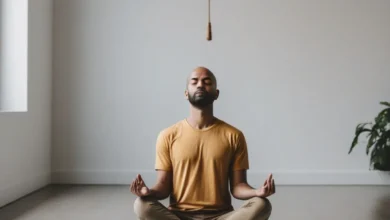Top 5 Breathwork Challenges for Deep Relaxation

Are you feeling overwhelmed by daily stress? Breathwork exercises for relaxation might be exactly what you need. Your breath has incredible power to calm your mind and body. Simple breathing techniques can transform your stress response in minutes.
Why Start a Breathwork Practice?
Research shows that controlled breathing directly impacts your nervous system. A 2020 study found that regular breathwork reduces anxiety by 40%. Breathing techniques for stress relief work faster than many other relaxation methods. Your body responds to proper breathing patterns almost immediately.
The Science Behind Breathwork
Your breath connects directly to your body’s relaxation response. Deep breathing activates your parasympathetic nervous system naturally. This slows your heart rate and reduces stress hormones quickly. Regular practice strengthens this relaxation response over time.
Key Benefits of Regular Breathwork:
- Reduces anxiety levels significantly
- Improves sleep quality naturally
- Boosts mental clarity and focus
- Lowers blood pressure effectively
- Enhances emotional regulation skills
Research Highlight: Studies show 10 minutes of daily breathwork reduces stress by 30%.
Getting Started with Breathwork
Mindful breathing challenges help you build a consistent daily practice. Here’s what you need to know before starting your journey.
Essential Guidelines for Beginners:
Best Time to Practice:
- Early morning works best for most people
- Try practicing before stressful situations
- Evening sessions improve sleep quality
- Lunch breaks offer perfect practice opportunities
Correct Posture Matters:
- Sit with your spine straight but relaxed
- Keep your shoulders away from your ears
- Plant your feet firmly on the ground
- Rest your hands comfortably on your legs

Safety First: Important Considerations
Always start slowly with new breathing techniques. Listen to your body’s signals carefully. Stop if you feel dizzy or uncomfortable.
Pro Tips for Beginners:
- Practice in a quiet, comfortable space
- Start with just 5 minutes daily
- Focus on gentle, natural breaths
- Don’t force or strain your breathing
Remember: Your breath should feel comfortable and natural.
Challenge 1: Box Breathing for Beginners
Box breathing calms your mind quickly and effectively. The military uses this technique for instant stress relief. It’s perfect for both beginners and experienced practitioners.
How to Practice Box Breathing:
- Find a comfortable seated position.
- Exhale completely through your mouth.
- Inhale through your nose for 4 counts.
- Hold your breath for 4 counts.
- Exhale through your mouth for 4 counts.
- Hold empty for 4 counts.
- Repeat this cycle for 5 minutes.
Daily Progress Guide:
- Day 1: Practice for 3 minutes
- Day 2: Increase to 4 minutes
- Day 3: Try 5 minutes
- Day 4: Maintain 5 minutes twice daily
- Day 5: Practice whenever you feel stressed
Success Tip: Count slowly and steadily during each phase.
Signs You’re Doing It Right:
- Your shoulders relax naturally
- Your mind feels clearer
- Your heart rate slows down
- Your body feels more peaceful
Challenge 2: Extended Exhale Practice
This breathing technique for stress relief works wonders for deep relaxation. Your exhale activates your body’s natural calming response. Longer exhales create deeper relaxation states.

Daily Practice Guide:
| Day | Inhale Count | Exhale Count | Minutes |
|---|---|---|---|
| 1 | 4 | 6 | 5 |
| 2 | 4 | 7 | 6 |
| 3 | 4 | 8 | 7 |
| 4 | 5 | 8 | 8 |
| 5 | 5 | 9 | 10 |
Key Benefits:
- Reduces anxiety quickly
- Promotes better sleep
- Lowers blood pressure naturally
- Calms racing thoughts effectively
Common Mistakes to Avoid:
- Don’t force long exhales
- Never strain your breath
- Avoid tense shoulders
- Don’t rush the practice
Important: Keep your breathing smooth and comfortable.
Progress Markers:
- Your exhales feel more natural
- You notice increased calm
- Your sleep improves significantly
- Daily stress affects you less
Pro Tip: Practice this technique before stressful situations.
Challenge 3: Alternate Nostril Breathing
Ancient yogis used this breathwork exercise for relaxation for centuries. Modern science confirms its remarkable benefits. This technique balances both sides of your brain.
Step-by-Step Guide:
- Sit comfortably with a straight spine.
- Rest your left hand on your knee.
- Fold your right index and middle fingers down.
- Close your right nostril with your right thumb.
- Inhale slowly through your left nostril.
- Close your left nostril with your ring finger.
- Release your thumb and exhale through your right nostril.
- Inhale through your right nostril.
- Close right nostril and exhale through left.
Daily Practice Schedule:
- Morning: 5 rounds
- Afternoon: 7 rounds
- Evening: 5 rounds
Health Warning: Skip this practice if you have nasal congestion.
Expected Benefits:
- Mental clarity improves significantly
- Stress levels drop naturally
- Focus sharpens quickly
- Sleep quality enhances noticeably
Challenge 4: The 4-7-8 Breathing Method
Dr. Andrew Weil developed this powerful relaxation technique. It acts like a natural tranquilizer for your nervous system. Many people report improved sleep within days.

Quick Reference Guide:
| Phase | Count | Action |
|---|---|---|
| Inhale | 4 | Through nose |
| Hold | 7 | Keep breath in |
| Exhale | 8 | Through mouth |
| Repeat | – | 4 cycles total |
Best Times to Practice:
- Before morning meetings
- During lunch breaks
- After work stress
- Before bedtime
Progress Guide:
Week 1:
- Morning: 2 cycles
- Evening: 2 cycles
Week 2:
- Morning: 3 cycles
- Evening: 3 cycles
Week 3:
- Morning: 4 cycles
- Evening: 4 cycles
Safety Note: Start slowly with this powerful technique.
Success Indicators:
- Faster stress relief
- Easier time falling asleep
- Reduced anxiety levels
- Better emotional control
Challenge 5: Coherent Breathing
Coherent breathing synchronizes your heart and breath beautifully. Scientists call this technique “resonant breathing” for good reason. It creates harmony between vital body systems.
The Basic Practice:
- Inhale for 5 seconds.
- Exhale for 5 seconds.
- Maintain this rhythm steadily.
- Practice for 10 minutes daily.
- Notice your heart rate settling.
Scientific Benefits:
- Improves heart rate variability
- Balances nervous system quickly
- Reduces cortisol levels naturally
- Enhances brain function significantly
Research Note: Studies show improved mood within two weeks.
Tracking Your Progress
Monitor your journey with these simple tracking methods. Small improvements add up to significant changes. Regular tracking keeps you motivated.
Daily Tracking Template:
| Date | Practice | Duration | Stress Level (1-10) | Notes |
|---|---|---|---|---|
| Day 1 | Box | 5 min | Before: 8 After: 5 | Felt calmer |
| Day 2 | 4-7-8 | 7 min | Before: 7 After: 4 | Better sleep |

Common Challenges and Solutions
Challenge: “I can’t focus.”
Solution: Start with just one minute. Count your breaths slowly. Build gradually.
Challenge: “I feel anxious.”
Solution: Use shorter sessions initially. Focus on exhales only. Progress slowly.
Challenge: “I don’t have time.”
Solution: Practice during daily activities. Try breathing during commutes. Use lunch breaks.
Challenge: “I forget to practice.”
Solution: Set phone reminders. Link practice to existing habits. Start small.
Remember: Every breath counts toward better health.
Moving Forward
Your breath holds incredible power for transformation. Regular practice brings lasting benefits. Small daily efforts create significant changes.
Next Steps:
- Choose one technique to master
- Practice for just 5 minutes daily
- Track your progress consistently
- Join online breathing communities
- Share your journey with others
Final Thoughts
Start your mindful breathing challenge today. Your journey to relaxation begins with one breath. Small steps lead to remarkable transformations.



